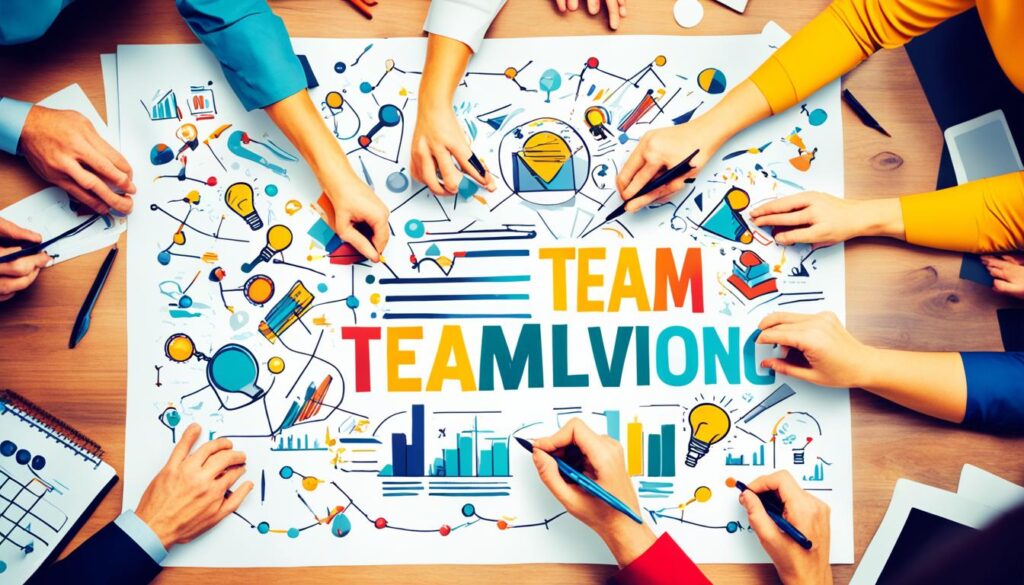Imagine a team working on a project with high ambitions and tight deadlines. At first, everyone is excited and motivated, ready to tackle any challenge that comes their way. But as time goes on, they start to encounter roadblocks. Communication becomes strained, disagreements arise, and progress slows down. What was once a harmonious team now struggles to work together effectively.
This is a common scenario in many workplaces. Team dynamics play a vital role in determining the success or failure of a project. It’s not just about individual skills and talents, but also about how well team members collaborate, communicate, and support each other.
That’s where team dynamics assessment comes in. It provides a way to evaluate and analyze the interactions, relationships, and overall performance of a team. By understanding the strengths and weaknesses of the team, leaders can identify areas for improvement and implement strategies that foster better teamwork.
Key Takeaways:
- Team dynamics assessment is crucial for assessing and improving team performance.
- Effective collaboration, communication, and support are essential for positive team dynamics.
- Identifying strengths and weaknesses helps leaders implement strategies to enhance teamwork.
- Team dynamics assessment leads to increased productivity and job satisfaction.
- Addressing issues and implementing effective strategies can boost team synergy and cohesion.
The Significance of Team Dynamics
Strong team dynamics play a crucial role in the success of a team. It establishes positive team relationships, fosters open communication, encourages commitment, promotes optimistic thinking, and enables effective conflict resolution. When team members understand their roles, project objectives, and have a clear direction, they can work together harmoniously towards a common goal.
Open communication is a cornerstone of successful team dynamics. It allows team members to share ideas, provide feedback, and address project concerns promptly, leading to efficient problem-solving and minimizing errors. By creating an environment where everyone feels comfortable expressing their thoughts, a team can create a foundation of trust and collaboration.
A committed team is willing to stay dedicated to the project even in challenging times. They demonstrate a sense of ownership and take responsibility for their contributions, understanding how their work impacts the overall success of the team. Commitment fosters resilience and ensures that team members stay focused on achieving their goals, even when faced with obstacles.
Optimistic thinking is another essential aspect of team dynamics. It involves maintaining a positive mindset, embracing challenges as opportunities for growth, and remaining motivated throughout the project. Optimistic teams are better equipped to handle setbacks and find creative solutions, ultimately driving success.
Conflict resolution is a necessary skill for effective team dynamics. By promoting open dialogue and discussions, team members can address conflicts constructively, leading to tension relief and strengthened relationships. Embracing conflict as an opportunity for growth allows teams to find innovative solutions and prevent disagreements from causing long-term damage.
Overall, team dynamics highlight the importance of positive relationships, open communication, commitment, optimistic thinking, and conflict resolution within a team. These elements contribute to a collaborative and productive work environment, where team members can thrive and achieve their goals.
Factors Affecting Team Dynamics
Team dynamics play a crucial role in the success of any project, but they can be negatively affected by various factors. Addressing these factors is essential in order to improve team dynamics and foster a collaborative and productive work environment.
1. Weak Leadership
Weak leadership can have a detrimental impact on team dynamics. When leaders lack clear direction or fail to provide guidance and support, it can lead to confusion among team members. Internal conflicts may arise, and the team’s focus may become misguided. Strong leadership, on the other hand, can provide a clear sense of direction, promote open communication, and empower team members to perform at their best.
2. Excessive Deference to Authority
Excessive deference to authority can inhibit open discussions and stifle creativity within a team. When team members feel compelled to always agree with authority figures, they may hesitate to voice their opinions or propose alternative ideas. This can hinder the team’s ability to think critically and make informed decisions. Encouraging a culture of open communication and valuing diverse perspectives can help overcome this challenge.
3. Groupthink
Groupthink occurs when the desire for agreement within a team outweighs the pursuit of the best solution. In such situations, team members may conform to popular opinions or withhold dissenting views, resulting in poor decision-making. To combat groupthink, it is important to encourage constructive debate, welcome dissenting opinions, and promote a culture of critical thinking and open-mindedness.
4. Blocking
Blocking refers to the act of disrupting the flow of information within a team. It can manifest in various ways, such as withholding important information or preventing others from actively participating in discussions. Blocking disrupts effective communication and hinders progress. Creating an environment where all team members feel comfortable sharing information and ideas is crucial in overcoming blocking.
5. Evaluation Apprehension
Evaluation apprehension occurs when team members are reluctant to speak up or contribute due to fear of criticism or negative evaluation. This can limit the diversity of ideas and perspectives within the team, stifling innovation and creativity. Fostering a supportive and non-judgmental atmosphere where feedback is constructive and focused on growth can help alleviate evaluation apprehension.
6. Free Riding
Free riding takes place when some team members do not contribute adequately to the group’s work. This can lead to frustration and resentment among other team members, hampering overall productivity and collaboration. Establishing clear roles and responsibilities, setting expectations for individual contributions, and promoting accountability are effective ways to discourage free riding.
By addressing these factors and implementing strategies to mitigate their negative impact, teams can foster a positive and productive work environment that elevates team dynamics and facilitates successful project outcomes.
| Factors Affecting Team Dynamics | Solutions |
|---|---|
| Weak Leadership | Provide clear direction and support, address conflicts promptly |
| Excessive Deference to Authority | Cultivate an open culture of communication and value diverse perspectives |
| Groupthink | Encourage constructive debate, welcome dissenting opinions, promote critical thinking |
| Blocking | Create an environment of trust and openness, encourage active participation |
| Evaluation Apprehension | Promote supportive feedback culture focused on growth and development |
| Free Riding | Set clear roles and expectations, foster accountability |
Strategies for Improving Team Dynamics
To improve team dynamics and foster a collaborative and productive work environment, implementing effective strategies is essential. By investing in leadership development programs, communication skills training, conflict resolution training, team building activities, and personality assessments, teams can enhance their dynamics and achieve better results.
Leadership Development Programs
Leadership plays a crucial role in shaping team dynamics. By providing leadership development programs, organizations can empower leaders to enhance their skills and promote better teamwork. These programs offer training and guidance on effective leadership strategies, communication techniques, and decision-making processes, enabling leaders to inspire and motivate their teams.
Communication Skills Training
Effective communication lies at the core of successful team dynamics. By providing communication skills training, team members can improve their interpersonal communication, active listening, and conflict resolution skills. This training enables them to express their ideas, share feedback, and collaborate effectively, fostering a positive and open environment for teamwork.
Conflict Resolution Training
Conflicts are inevitable in any team. However, addressing conflicts in a constructive manner is crucial for maintaining healthy team dynamics. Conflict resolution training equips team members with the necessary skills to identify, address, and resolve conflicts effectively. They learn techniques for active listening, negotiation, and finding win-win solutions, enabling them to navigate conflicts and strengthen team relationships.
Team Building Activities
Team building activities provide opportunities for team members to connect, build trust, and enhance team dynamics. These activities can include team retreats, outdoor challenges, or collaborative projects. By engaging in team building activities, team members get to know each other outside of work, develop a sense of camaraderie, and enhance their collaboration skills, resulting in improved teamwork and a stronger bond among team members.
Personality Assessments
Understanding individual strengths, weaknesses, and preferences is essential for effective collaboration within a team. Personality assessments, such as the Myers-Briggs Type Indicator (MBTI) or DISC assessment, can provide valuable insights into team members’ personalities and communication styles. These assessments facilitate better understanding, empathy, and adaptation within the team, enhancing overall team dynamics and communication.

Implementing these strategies can lead to significant improvements in team dynamics, resulting in enhanced collaboration, increased productivity, and better outcomes for the business. By investing in leadership development, communication skills training, conflict resolution training, team building activities, and personality assessments, organizations can create a positive and highly effective team environment.
Evaluating the Impact of Team Building Activities
Evaluating the impact of team building activities is a crucial step in understanding their effectiveness and identifying areas for improvement. By employing a combination of methods, businesses can gain valuable insights into the impact these activities have on team dynamics. Let’s explore some effective evaluation strategies that provide both qualitative and quantitative data.
Pre and Post-Assessments
Pre and post-assessments, such as surveys and tests, are valuable tools for measuring the impact of team building activities. These assessments can measure individual attitudes, perceptions, skills, or knowledge related to team dynamics. By comparing the results before and after the activities, organizations can gauge the extent to which the activities have positively influenced team dynamics.
Feedback Collection
Collecting feedback from team members is an excellent way to gain qualitative insights into their experience with team building activities. By soliciting their input, organizations can understand how the activities have influenced their learning outcomes, collaboration, and overall satisfaction. Feedback can be collected through surveys, interviews, or focus groups to gather valuable perspectives and suggestions for improvement.
“The team building activities provided an opportunity for us to bond and understand each other’s strengths and weaknesses. It really enhanced our communication and problem-solving skills.” – Emily, Project Manager
Behavior and Results Observation
Observing and documenting the behavior and results of team members during and after team building activities can provide quantitative data on the impact. By objectively assessing individual and team performance, organizations can measure the tangible outcomes of the activities. This includes observing changes in communication patterns, collaboration, task completion, and overall productivity.
Combination of Methods
A comprehensive evaluation of team building’s impact on team dynamics requires a combination of qualitative and quantitative methods. By combining pre and post-assessments, feedback collection, and behavior and results observation, organizations can gain a holistic understanding of the overall effectiveness of team building activities. This multi-faceted approach allows for more accurate, well-rounded insights and can inform future initiatives for continuous improvement.

By evaluating the impact of team building activities through a combination of methods, organizations can make informed decisions about the effectiveness of these initiatives. This evaluation process enables companies to identify strengths, address weaknesses, and refine their approach to team building, ultimately enhancing team dynamics and driving overall success.
Conclusion
Effective team dynamics are essential for boosting productivity and improving team performance. By conducting thorough team dynamics assessments, businesses can identify and address factors that hinder positive dynamics, allowing teams to enhance collaboration and achieve better results. Implementing effective strategies such as leadership development programs, communication skills training, conflict resolution training, team building activities, and personality assessments can foster a positive team environment and improve overall team dynamics. Additionally, organizations should prioritize regular feedback and open communication channels to ensure that team members feel valued and heard. By fostering an inclusive atmosphere, teams can address any underlying issues and promote a culture of trust and respect. Ultimately, these concerted efforts enable teams to optimize team dynamics effectively, leading to enhanced innovation, higher morale, and sustained success in achieving their goals. Moreover, organizations can further refine their approach by regularly reviewing and adapting their boosting team performance strategies to align with evolving team needs and objectives. This proactive stance not only helps to sustain high levels of engagement and productivity but also empowers team members to take ownership of their roles. By consistently investing in the growth and development of team dynamics, businesses can cultivate an environment where creativity thrives and challenges are met with resilience.
Evaluating the impact of team building activities is crucial to understand their effectiveness in improving team dynamics. By using a combination of evaluation methods, including pre and post-assessments, feedback collection, and behavior and results observation, businesses can gain a comprehensive understanding of the effectiveness of these activities. This comprehensive evaluation approach ensures an accurate assessment of team dynamics improvements and helps businesses make informed decisions for future team development initiatives.
By focusing on team dynamics assessment, businesses can maximize their team’s effectiveness and achieve significant productivity improvements. By understanding the significance of team dynamics, addressing barriers, implementing effective strategies, and evaluating the impact of team building activities, businesses can create an environment that fosters collaboration, innovation, and success. Investing in team dynamics assessment and improvement is a valuable endeavor that can lead to positive organizational outcomes and contribute to long-term success in today’s competitive business landscape.
FAQ
What is team dynamics assessment?
Team dynamics assessment is the process of evaluating the interactions, relationships, and overall performance of a team. It involves analyzing factors such as communication, collaboration, leadership, and individual contributions to identify strengths and areas for improvement.
Why is teamwork evaluation important?
Teamwork evaluation is important because it allows businesses to identify and address issues that may be hindering team performance. By assessing team dynamics, businesses can improve communication, collaboration, and problem-solving skills, leading to increased productivity and job satisfaction.
What factors affect team dynamics?
Team dynamics can be affected by factors such as weak leadership, excessive deference to authority, groupthink, blocking, evaluation apprehension, and free riding. These factors can hinder effective communication, decision-making, and collaboration within a team.
How can team dynamics be improved?
Team dynamics can be improved through effective strategies such as leadership development programs, communication skills training, conflict resolution training, team building activities, and personality assessments. These strategies help enhance collaboration, trust, and understanding among team members.
How is the impact of team building activities evaluated?
The impact of team building activities can be evaluated through pre- and post-assessments, feedback collection from team members, observation of behavior and results, and a combination of qualitative and quantitative evaluation methods. This allows businesses to measure the effectiveness of team building activities in improving team dynamics.
How does team dynamics assessment contribute to productivity improvement?
Team dynamics assessment helps businesses identify and address issues that may be impeding productivity. By understanding and improving team dynamics, such as communication and collaboration, businesses can create a more positive and efficient work environment, leading to increased productivity.


